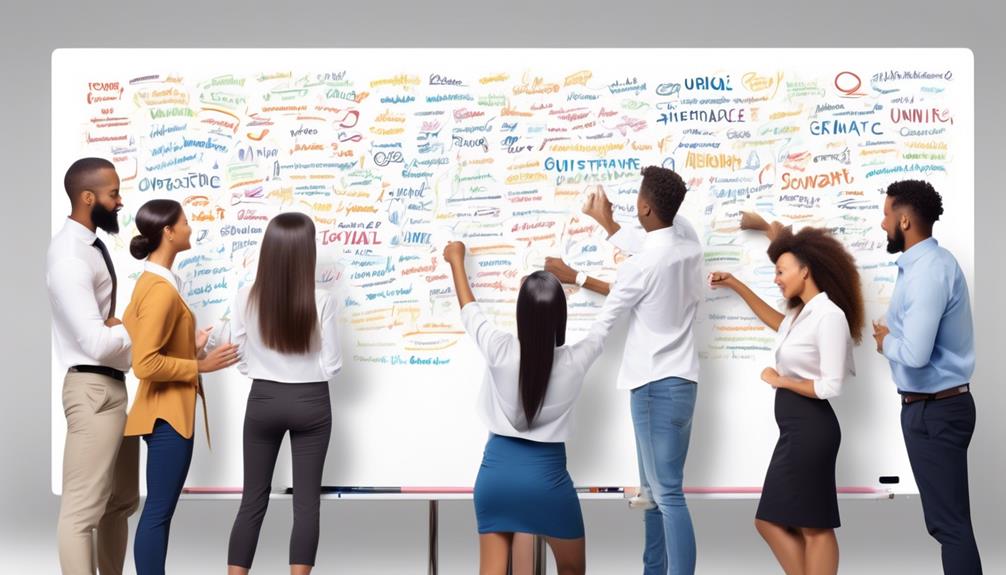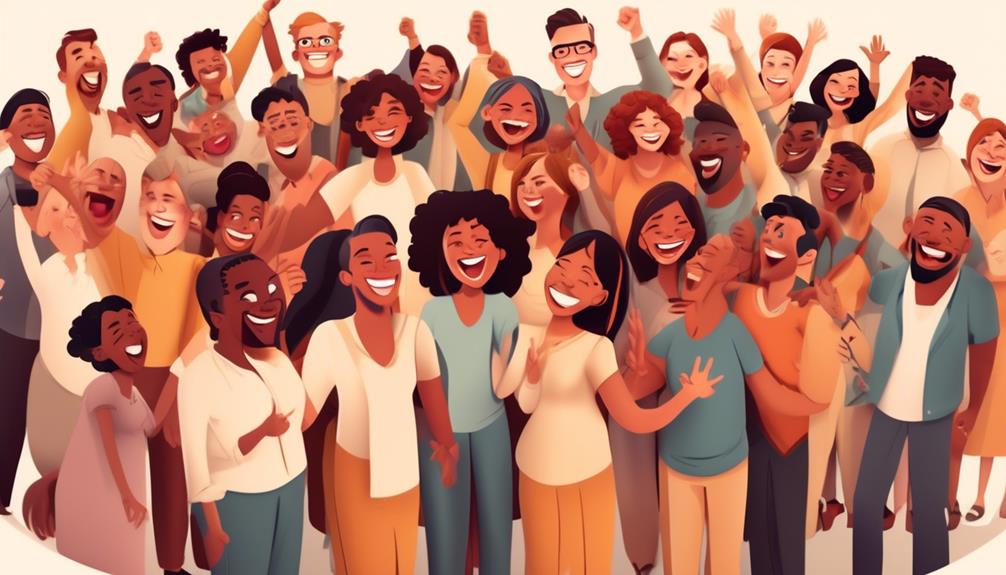Do you ever wonder if there are practical and effective ways to improve workplace unity through goal-setting exercises?
We've all experienced the challenges of maintaining cohesion and collaboration within a team, and it's essential to explore methods that can address these issues.
In the following discussion, we will explore seven goal-setting exercises that have proven to be effective in promoting unity and teamwork in the workplace. These exercises not only encourage individuals to set and work towards common goals but also foster a sense of camaraderie and shared purpose among team members.
Key Takeaways
- Goal-setting exercises can enhance team collaboration and open communication in the workplace.
- Regular check-ins and progress tracking are crucial for measuring goal achievement and providing support.
- Defining success criteria is important for evaluating goal achievement, and adhering to the SMART criteria can guide this process.
- Aligning individual and team goals with the organization's mission and vision fosters unity, collaboration, and purpose within the team.
Imagine One Year From Now

Encouraging employees to envision their ideal work-life one year from now can help foster motivation and goal alignment within the workplace. By imagining one year from now, team collaboration and open communication are enhanced, creating a shared vision for the future. This exercise is vital in the goal-setting process, as it allows individuals to set clear, achievable goals that contribute to the overall success of the team.
To ensure the effectiveness of this exercise, regular check-ins are essential to measure progress and provide support where needed. These check-ins can take place during team meetings, where individuals can openly discuss their envisioned future and the steps they're taking to get there. This open communication fosters a supportive and collaborative environment where team members can offer insights and encouragement.
Moreover, the exercise of imagining one year from now can be integrated into the goal-setting process through various techniques such as 'Sticky Notes for One or Many,' 'One-Word Goal Setting,' 'Mind Mapping,' and 'Work Bingo.' Each of these methods contributes to the clarity and alignment of goals, ultimately leading to a more cohesive and motivated workplace.
Work Bingo

Work Bingo is a goal-setting exercise that promotes engagement and collaboration among employees by incorporating tasks related to their professional goals on a bingo card. This team-building activity encourages team members to work together towards achieving their SMART goals while fostering a sense of unity within the workplace.
Here's why Work Bingo is an effective exercise for workplace goal-setting:
- Alignment with Team Objectives: Work Bingo aligns individual tasks with team objectives, ensuring that employees are working towards common goals while pursuing their personal aspirations.
- Prioritization and Progress Tracking: It provides a structured approach for employees to prioritize their professional goals and track their progress in a fun and interactive manner.
- Ownership and Accountability: Work Bingo encourages employees to take ownership of their goals and be accountable for their progress, promoting a sense of responsibility and motivation.
- Motivation and Accomplishment: By participating in Work Bingo, employees gain motivation, focus, and a sense of accomplishment as they make strides towards their professional aspirations.
Work Bingo is a valuable tool for fostering workplace unity and enhancing the goal-setting process within the team.
Definition of Success
As a team, we need to have a clear understanding of what success means for us.
This includes defining the criteria for success, understanding what it takes to achieve our goals, and aligning our efforts with the team's objectives.
Success Criteria
Understanding success criteria is crucial for aligning individuals and teams towards achieving their goals effectively. Utilizing goal setting, success criteria provide a clear roadmap for evaluating the achievement of a goal or objective. They encompass specific outcomes, measurable results, relevance to the overall objective, and a defined timeline for achievement. This ensures that team members have a shared understanding of what constitutes successful goal attainment, fostering team building and effective goals.
By adhering to the SMART (Specific, Measurable, Achievable, Relevant, Time-bound) criteria, success criteria enable team bonding and goal alignment.
Ultimately, success criteria serve as a guiding framework for assessing progress, making informed decisions, and celebrating achievements.
Achieving Goals
To truly achieve our goals, it is essential to clearly define the criteria for success and ensure that they align with the SMART framework. Setting and achieving goals that improve team collaboration among team members requires making every goal a relevant one. This entails instilling a sense of purpose and urgency within the team, aligning individual goals with overall objectives and long-term goals. Tracking progress is vital for evaluating the effectiveness of the strategies employed and for making necessary adjustments. The table below illustrates how the SMART framework can be applied to achieve success in goal-setting.
| Specific | Measurable | |
|---|---|---|
| Goals should be clear and precise. | Progress should be quantifiable and observable. | |
| Achievable | Relevant | Time-bound |
| Goals should be realistic and attainable. | They should be aligned with the team's objectives. | They should have a specific deadline. |
Team Alignment
Aligning individual and team goals with the overall mission and vision of the organization is crucial in fostering workplace unity and collaboration. When team alignment on the definition of success is achieved, it provides a framework for setting effective goals to achieve the team's overall mission.
To ensure that goals are aligned, it's important to make sure your goals are specific, measurable, attainable, relevant, and time-bound. This approach helps team members understand what's expected and how their contributions impact the team's success.
Additionally, team alignment helps everyone on the team understand the importance of setting goals and how their individual efforts contribute to the teams' overall success. This shared understanding fosters a sense of unity, collaboration, and purpose within the team.
Mind Mapping

Using mind mapping, teams can visually organize and connect information in a structured and interconnected way, fostering collaboration and enhancing creativity in the workplace. Mind Mapping is a powerful technique for setting and achieving goals as it helps individuals and teams to make sense of complex ideas and concepts, leading to more effective and efficient goal setting. By visually representing goals and the steps needed to achieve them, teams can work together more effectively and align their efforts towards a common objective. Mind Mapping also aids in the process of Setting SMART Goals (Specific, Measurable, Achievable, Relevant, Time-bound), ensuring that goals are well-defined and attainable. Here's an example of how teams can use mind mapping to work together effectively in setting personal and team goals:
| Personal Goals | Team Goals | Steps to Achieve |
|---|---|---|
| Improve time management skills | Increase team productivity by 15% | 1. Identify time-wasting activities |
| Achieve a professional certification | Enhance cross-departmental communication | 2. Enroll in certification course |
| Develop leadership abilities | Launch a new product line | 3. Attend leadership training seminars |
One-Word Goal Setting

Fostering workplace unity and collaboration, One-Word Goal Setting simplifies the goal-setting process by focusing on a single word to encapsulate a specific objective. This approach encourages clarity, concentration, and alignment, making it easier to articulate and remember individual or team goals.
Here's why it's effective:
- Clarity and Concentration: One-Word Goal Setting promotes a clear and concise way of articulating aspirations, providing a straightforward framework for planning and execution.
- Alignment and Unity: This method is effective in creating a shared vision and direction, fostering unity and collaboration among team members.
- Flexibility and Adaptability: It allows for flexibility and adaptability, empowering individuals or teams to adjust and realign their goals according to changing circumstances or priorities.
- Simplified Planning: It provides a clear direction for both professional and personal development, allowing individuals to set achievable goals while identifying common goals for the group.
The Winning Lottery Ticket

Upon envisioning a significant windfall, individuals are prompted to reassess their priorities and take into account the core values that shape their personal and professional aspirations. This exercise teaches us the importance of setting goals that align with our values and making necessary adjustments as circumstances change.
In the workplace, this translates to focusing on what's most important and applying our core values to achieve the desired outcome. By keeping track of our progress toward these goals, we can ensure personal growth and increase sales within the team.
The winning lottery ticket exercise also emphasizes the need for adaptability in goal setting. Just as our priorities would shift if we were to come into a large sum of money, our strategies and approaches within the workplace may need to change as well. This exercise encourages us to consider new strategies that align with our core values, making it easier to work together within the team and achieve our common goals.
Ultimately, the exercise prompts us to reflect on what truly matters and how we can apply these insights to our professional endeavors.
Keep the Ball in the Air

After reflecting on the need for adaptability and aligning our strategies with core values, we can transition to the team exercise 'Keep the Ball in the Air', which promotes teamwork and effective communication to achieve a common goal. This exercise focuses on coordination, collaboration, and quick decision-making in a dynamic environment, fostering workplace unity and effective goal-setting.
Here are four key points to consider when implementing 'Keep the Ball in the Air':
- Team Coordination: The activity requires seamless coordination among team members to ensure the balloon stays afloat, mirroring the need for synchronized efforts in achieving workplace goals.
- Effective Communication: Participants must communicate clearly and efficiently to keep the balloon in the air, emphasizing the significance of open and transparent communication in the workplace.
- Adaptability and Strategy: As the exercise unfolds, teams must adapt their strategies to keep the balloon from touching the ground, highlighting the importance of adaptability and strategic thinking in goal-setting.
- Unity and Cohesion: Engaging in this fun and interactive exercise fosters unity and cohesion within the team, reinforcing the value of collective efforts in attaining shared objectives.
'Keep the Ball in the Air' serves as a practical and engaging tool to enhance teamwork, accountability, and goal-oriented collaboration in the workplace.
Frequently Asked Questions
How Do You Make Goal-Setting Fun at Work?
We make goal-setting fun at work by infusing creativity and teamwork. We engage in activities like Standing Ovation and Reflect Your Yesterday to envision success and learn from the past. This fosters a sense of unity and purpose.
What Are the 5 Components of Effective Goal-Setting?
We define effective goal-setting as specific, measurable, achievable, relevant, and time-bound. These components provide clarity, track progress, maintain motivation, ensure impact, and create urgency. They are essential for success in any setting.
What Are the Goal-Setting Icebreaker Activities?
We've explored goal-setting icebreaker activities like Standing Ovation, Reflect Your Yesterday, Sticky Notes for One or Many, The Balloon in The Air, and Note Down Your Average Perfect Day. These exercises enhance workplace unity and foster goal alignment.
How Will I Work With My Team Members to Set Goals More Effectively?
We'll collaborate openly and utilize visualization techniques to align and set goals effectively. Incorporating activities like sticky notes and the balloon in the air fosters inspiration and teamwork. Utilizing SMART goals and engaging platforms ensures successful implementation.
How Can Professional Development Goal-Setting Exercises Improve Workplace Unity?
Professional development goal-setting exercises can greatly improve workplace unity. When employees come together to discuss, plan, and set work development goals, they establish a sense of teamwork and common purpose. This shared vision can lead to greater collaboration, higher morale, and a more unified and productive work environment.
Conclusion
As we wrap up these goal-setting exercises, it's exciting to think about the potential impact on our workplace unity.
But the real magic happens when we put these exercises into action and see the positive changes unfold.
So, let's embrace these activities and the unity they can bring to our team.
Who knows what amazing things we can achieve together in the next year?
The possibilities are endless.
Joy, as our Editor in Chief, ensures the highest standard of content. Her talent in writing is complemented by her attention to detail and passion for literature and culture. Joy’s expertise and love for the English language shine through in her editorial work, making each piece a testament to quality and clarity.










